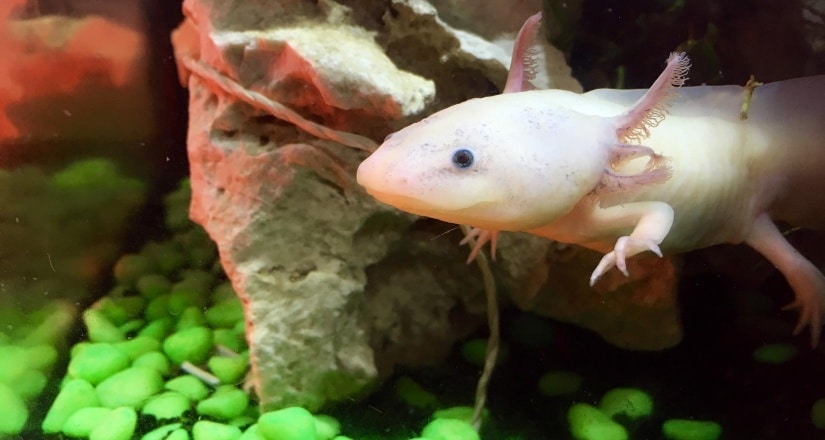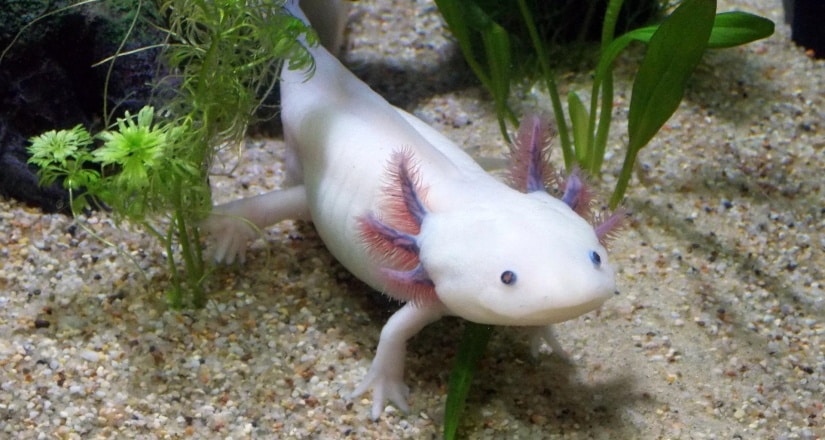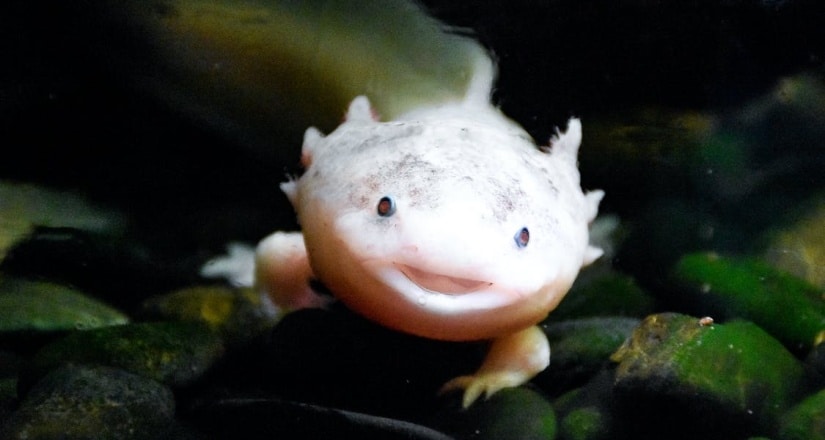Axolotls have become a favorite for many pet owners because of their baby faces and various colors. There are several types of axolotls, but one thing that most have in common is morphing, where it goes from a sea to a land creature. Most axolotl owners want to experience morphing firsthand. However, this process is not a simple affair. It carries several risks.
So keep a close eye on your axolotl, and when you notice that it’s starting to morph, take the necessary measures to provide protection and care.
How Do You Know That Your Axolotl Is Morphing?
You’ll notice the following signs when your axolotl starts morphing, but if you want to learn more about the process, it’s covered in more detail here.
Bulging Eyes
The moment your axolotl starts the morphing process, their eyes start protruding, giving your precious pet a pop-eyed look.
Developing Eyelids
When they are in the water, axolotls do not have an eyelid, which is crucial for land animals as it’s used for blinking. So when your axolotl starts morphing, it will also start developing an eyelid to help it adjust to life on land.
Thickening Back Legs
Axolotls have thin and spindly legs that make swimming easier. However, as they morph, their legs will start to thicken in preparation for supporting their body weight on land.
Skin Changes
Once your axolotl starts morphing, you’ll notice that their skin color will begin to become darker and the patterns on it become more intense.
Loss of Webbing on the Feet
In the water, an axolotl’s feet are webbed to make swimming easier. However, as they morph, the skin connecting the toes starts to disappear, and the toes become thicker and longer. This gives them the support they need when walking on the ground.
Loss of Gills
In the water, axolotls use gills for breathing, and as they start to morph, the gills disappear. Land animals use lungs, so your morphing axolotl will have no more need for the gills.
Loss of Fins
Fins together with webbed feet help propel an axolotl in the water. Like gills, the dorsal and caudal fins will disappear into its body once the axolotl begins to morph. And it will develop a thin tail that looks like a lizard’s.
A morphed axolotl changes into something different than it was before, which can be quite baffling for the pet owner. Some new owners who did not expect morphing might feel like they were cheated. So you will want to do your research on what morphing means and how to adapt to the axolotl’s changing needs.
What Are the Risks of Axolotl Morphing?

Axolotls are an endangered species in the wild due to the destruction of their natural habitat. And when they undergo metamorphosis, whether in captivity or the wild, they face the following risks.
Drowning
In the water, axolotls breathe through their gills, but once they start morphing, the gills disappear into their body. This means they can no longer breathe underwater and could drown. That’s why it’s recommended that once you notice your axolotl morphing, you should move it into a tank where the water does not cover its whole body to keep it from drowning.
It would be best if you also provide something it can crawl on or at least prop up its head. You can use a stone or an overturned plate
They use their fins and webbed feet in the water to swim. But as they morph, the fins disappear, and they develop thick legs and lose their webbing, which makes it hard for them to swim and come up for air, resulting in drowning.
Low Immunity
Axolotls are the weakest when morphing, making them highly susceptible to diseases and infections. Their regeneration features will not work during this period, and if they get sick, they might end up dying. Axolotl owners are advised to keep the tank clean and to avoid touching their pets during this transition stage. If you must, wear clean gloves or wash your hands, and do not use any soap.
Starvation
Although some axolotl feed during the metamorphosis stage, many resist eating. Don’t be alarmed, as this is pretty normal. Their bodies undergo many changes, and feeding might not be a priority.
Before morphing, your axolotl doesn’t have a tongue; instead, it has an unmovable flat pad fixed at the bottom of his mouth. However, it will start to develop a natural and movable tongue after it starts morphing. You are advised to give your axolotl time to adjust to the new changes.
It’s also wise to note that when they are morphing, their digestive tract and intestines start shortening. According to research, it shrinks approximately 70 percent. Therefore, they won’t feel as hungry as before. However, expect them to start eating within a week or two. Even so, keep offering them food throughout the whole transition process.
Intestinal Perforation
Your axolotl is still weak and adjusting, so make sure that their food is soft and cannot cause damage. If you start them with earthworms, ensure they are cut in two to make it easy for them to eat. If you feed them whole earthworms, you risk your axolotl having their intestines perforated by the worm as it wiggles around trying to escape.
You can also feed them using gut-loaded crickets and dubia roaches.
If your axolotl refuses to eat even after a week, use this trick to feed them. Place them in a small tub of water, then cut up earthworms into small pieces and throw them in. As the worms thrash in the water, the scent of blood will reach your axolotl’s nostrils, triggering their feeding urges. Alternatively, you can feed them by hand.
Dehydration
Just because your axolotl has morphed doesn’t mean they don’t love water. Remember, their skin is permeable, so you must ensure that their enclosure is always moist. You can use wet paper towels and place a water basin where they can swim and hydrate. Also, always use dechlorinated water and change it regularly.
Shorter Lifespan
Axolotls have a lifespan of 10 to 15 years; in normal conditions, they are not supposed to undergo metamorphosis. Research shows that when axolotls morph, their lifespan is reduced, especially if you force them into morphing. For instance, if it was supposed to live for ten years, its lifespan is reduced to five. Their reproduction system may also be affected as they adapt to the new body.
What Are the Causes of Morphing?
Morphing in axolotls is triggered by exposure to iodine, which changes its brain, causing the production of thyroxine, which triggers morphing. If you want your pet to remain in the water, avoid giving it food with iodine. However, add iodine to its food if you’re hoping to trigger its transition.
You can also trigger morphing in axolotls through hybridization with species such as tiger salamander, which carries the morphing gene.
How to Care for a Morphing Axolotl

As your axolotl goes through the metamorphosis, you must provide optimal care to ensure it goes through the transition smoothly. Do the following.
- Remove your axolotl from its tank. This is because it will start losing some of the features that make it possible for it to survive underwater, such as the gills, fins, and webbed feet. Place it in a shallow tank and ensure the water does not rise above its body, allowing it to breathe without struggling.
- Provide a gradual landmass, such as a stone, where it can climb to escape the water.
- Place hiding places in the tank, such as trees and rocks, especially on the landmass, to provide it with places to hide. Many pets require such dedicated places. For instance, there are cat trees where cats can hang around, play, and have a good time.
- Cover the tank with a lid. A morphing axolotl can survive on land, so if you leave the tank open, you might find that it escaped.
Caring for a Morphed Axolotl
An entirely morphed axolotl requires a different care routine. For instance, you will need to create another living environment where they can roam and sleep, as they can no longer live fully submerged in water. You can think of this as similar to buying a new dog bed for a pet dog when the dog grows out of the existing one. However, their enclosure must always retain moisture as their skin is permeable.
Always cover their enclosure on all sides and top with a lid to prevent them from escaping. And a morphed axolotls eats more, so be sure to adjust its diet and feeding schedule. Their diet consists of crickets, slugs, waxworms, earthworms, and no shelled mealworms.
Note that morphed axolotls love to burrow and hide, so use a suitable substrate and place some artificial plants. And maintain the temperature between 65 and 72 degrees Fahrenheit.
Final Thoughts
If you have an axolotl, take extra care not to feed it with foods containing iodine as it triggers morphing. However, if morphing occurs, look out for the signs discussed above. And take extra care of your pet during this period as it’s at its weakest, and it is pretty easy to pick up diseases or infections.
After they complete their transition, please make the necessary adjustments to their living environment and diet.
